R1234ze(E) Flow Boiling inside a 2.5 mm ID Smooth Tube and Comparison against an Equivalent Microfin Tube
Abstract
1. Introduction
2. Experimental Facility and Test Section
3. Data Analysis
4. Experimental Results
4.1. Preliminary Considerations
4.2. Experimental Heat Transfer Coefficients and Frictional Pressure Drops
5. Comparisons
5.1. Comparison against an Equivalent Microfin Tube
5.2. Comparison against Empirical Correlations
6. Conclusions
Author Contributions
Funding
Institutional Review Board Statement
Informed Consent Statement
Data Availability Statement
Conflicts of Interest
References
- Brown, S.; Zilio, C.; Cavallini, A. Thermodynamic properties of eight fluorinated olefins. Int. J. Refrig. 2010, 33, 235–241. [Google Scholar] [CrossRef]
- Thol, M.; Lemmon, E.W. Equation of State for the Thermodynamic Properties of trans-1,3,3,3-Tetrafluoropropene [R-1234ze(E)]. Int. J. Thermophys. 2016, 37, 28. [Google Scholar] [CrossRef]
- Huber, M.L.; Assael, M.J. Correlations for the viscosity of 2,3,3,3-tetrafluoroprop-1-ene (R1234yf) and trans-1,3,3,3-tetrafluoropropene (R1234ze(E)). Int. J. Refrig. 2016, 71, 39–45. [Google Scholar] [CrossRef]
- Perkins, R.A.; Huber, M.L. Measurement and Correlation of the Thermal Conductivity of 2,3,3,3-Tetrafluoroprop-1-ene (R1234yf) and trans-1,3,3,3-tetrafluoropropene (R1234ze(E)). J. Chem. Eng. Data 2011, 56, 4868–4874. [Google Scholar] [CrossRef]
- Mulero, A.; Cachadina, I. Recommended Correlations for the Surface Tension of Several Fluids Included in the REFPROP Program. J. Phys. Chem. Ref. Data 2014, 43, 023104. [Google Scholar] [CrossRef]
- Lemmon, E.W.; Huber, M.L.; McLinden, M.O. NIST Standard Reference Database 23, NIST Reference Fluid Thermodynamic and Transport Properties, REFPROP, Version 10.0; Standard Reference Data Program; National Institute of Standards and Technology: Gaithersburg, MD, USA, 2018.
- Hodnebrog, O.; Etminan, M.; Fuglestvedt, J.S.; Marston, G.; Myhre, G.; Nielsen, C.J.; Shine, K.P.; Wallington, T.J. Global warming potentials and radiative efficiencies of halocarbons and related compounds: A comprehensive review. Rev. Geophys. 2013, 51, 300–378. [Google Scholar] [CrossRef]
- Park, J.E.; Vakili-Farahani, F.; Consolini, L.; Thome, J.R. Experimental study on condensation heat transfer in vertical minichannels for new refrigerant R1234ze(E) versus R134a and R245fa. Exp. Therm. Fluid Sci. 2011, 35, 442–454. [Google Scholar] [CrossRef]
- Del Col, D.; Bortolato, M.; Azzolin, M.; Bortolin, S. Condensation heat tranfer and two-phase frictional pressure drop in a single minichannel with R1234ze(E) and other refrigerants. Int. J. Refrig. 2015, 50, 87–103. [Google Scholar] [CrossRef]
- Liu, N.; Xiao, H.; Li, J. Experimental investigation of condensation heat transfer and pressure drop of propane, R1234ze(E) and R22 in minichannels. Appl. Therm. Eng. 2016, 102, 63–72. [Google Scholar] [CrossRef]
- Diani, A.; Campanale, M.; Cavallini, A.; Rossetto, L. Low GWP refrigerants condensation inside a 2.4 mm ID microfin tube. Int. J. Refrig. 2018, 86, 312–321. [Google Scholar] [CrossRef]
- Diani, A.; Camapanale, M.; Rossetto, L. Experimental study on heat transfer condensation of R1234ze(E) and R134a inside a 4.0 mm OD horizontal microfin tube. Int. J. Heat Mass Transf. 2018, 126, 1316–1325. [Google Scholar] [CrossRef]
- Yang, Y.; Li, M.; Wu, W.; Zhang, H.; Ma, Y. Condensation heat transfer characteristics of R1234ze(E) and R32 in a mini horizontal smooth tube. Sci. Tech. Built Env. 2019, 25, 889–904. [Google Scholar] [CrossRef]
- Vakili-Farahani, F.; Agostini, B.; Thome, J.R. Experimental study on flow boiling heat transfer of multiport tubes with R245fa and R1234ze(E). Int. J. Refrig. 2013, 36, 335–352. [Google Scholar] [CrossRef]
- Li, H.; Hrnjak, P. Heat transfer coefficient, pressure drop, and flow patterns of R1234ze(E) evaporating in microchannel tube. Int. J. Heat Mass Transf. 2019, 138, 1368–1386. [Google Scholar] [CrossRef]
- Yang, Z.Q.; Chen, G.F.; Yao, Y.; Song, Q.L.; Shen, J.; Gong, M.Q. Experimental study on flow boiling heat transfer and pressure drop in a horizontal tube for R1234ze(E) versus R600a. Int. J. Refrig. 2018, 85, 334–352. [Google Scholar] [CrossRef]
- Longo, G.A.; Mancin, S.; Righetti, G.; Zilio, C. Saturated flow boiling Of HFC134a and its low GWP substitute HFO1234ze(E) inside a 4 mm horizontal smooth tube. Int. J. Refrig. 2016, 64, 32–39. [Google Scholar] [CrossRef]
- Ong, C.L.; Thome, J.R. Macro-to-microchannel transition in two-phase flow: Part 1—Two phase flow patterns and film thickness measurements. Exp. Therm. Fluid Sci. 2011, 35, 37–47. [Google Scholar] [CrossRef]
- Diani, A.; Rossetto, L. Characteristics of R513A evaporation heat transfer inside small-diameter smooth and microfin tubes. Int. J. Heat Mass Transf. 2020, 162, 120402. [Google Scholar] [CrossRef]
- Rouhani, S.Z.; Axelsson, E. Calculation of void fraction in the subcooled and quality boiling region. Int. J. Heat Mass Transf. 1970, 13, 383–393. [Google Scholar] [CrossRef]
- Diani, A.; Mancin, S.; Cavallini, A.; Rossetto, L. Experimental investigation of R1234ze(E) flow boiling inside a 2.4 mm ID microfin tube. Int. J. Refrig. 2016, 69, 272–284. [Google Scholar] [CrossRef]
- Gungor, K.E.; Winterton, R.H.S. Simplified general corelation for saturated flow boiling and comparisons of correlations with data. Chem. Eng. Res. Des. 1987, 65, 148–156. [Google Scholar]
- Kim, S.M.; Mudawar, I. Universal approach to predicting saturated flow boiling heat transfer in mini/micro-channels—Part I. Two-phase heat transfer coefficient. Int. J. Heat Mass Transf. 2013, 64, 1239–1256. [Google Scholar] [CrossRef]
- Yu, J.; Momoki, S.; Koyama, S. Experimental study on surface effect on flow boiling heat transfer in horizontal tubes. Int. J. Heat Mass Transf. 1999, 42, 1909–1918. [Google Scholar] [CrossRef]
- Cavallini, A.; Del Col, D.; Matkovic, M.; Rossetto, L. Frictional pressure drop during vapor-liquid flow in minichannels: Modelling and experimental evaluation. Int. J. Heat Fluid Flow 2009, 30, 131–139. [Google Scholar] [CrossRef]
- Muller-Steinhagen, H.; Heck, K. A simple friction pressure drop correlation for two-phase flow in pipes. Chem. Eng. Proc. 1986, 20, 297–308. [Google Scholar] [CrossRef]
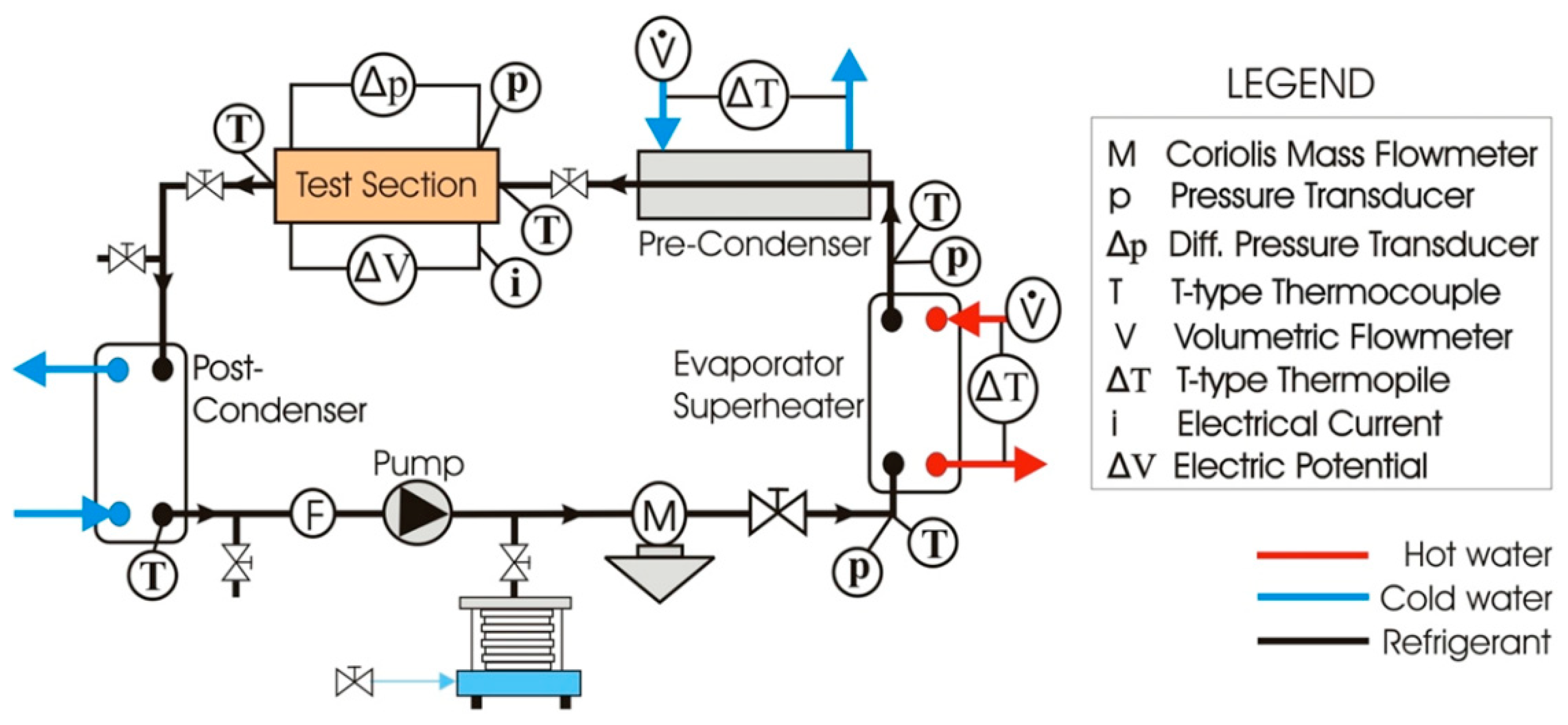
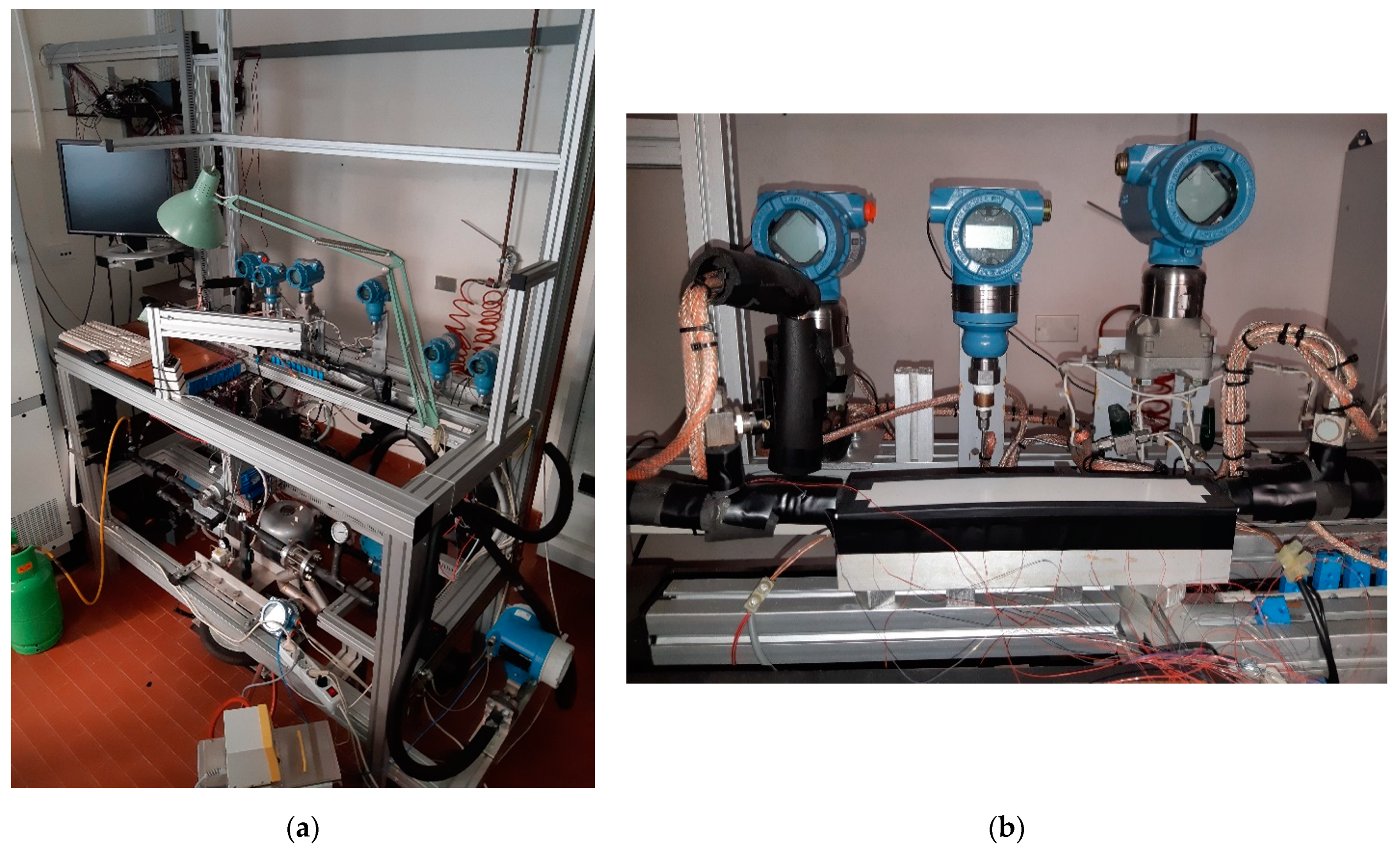
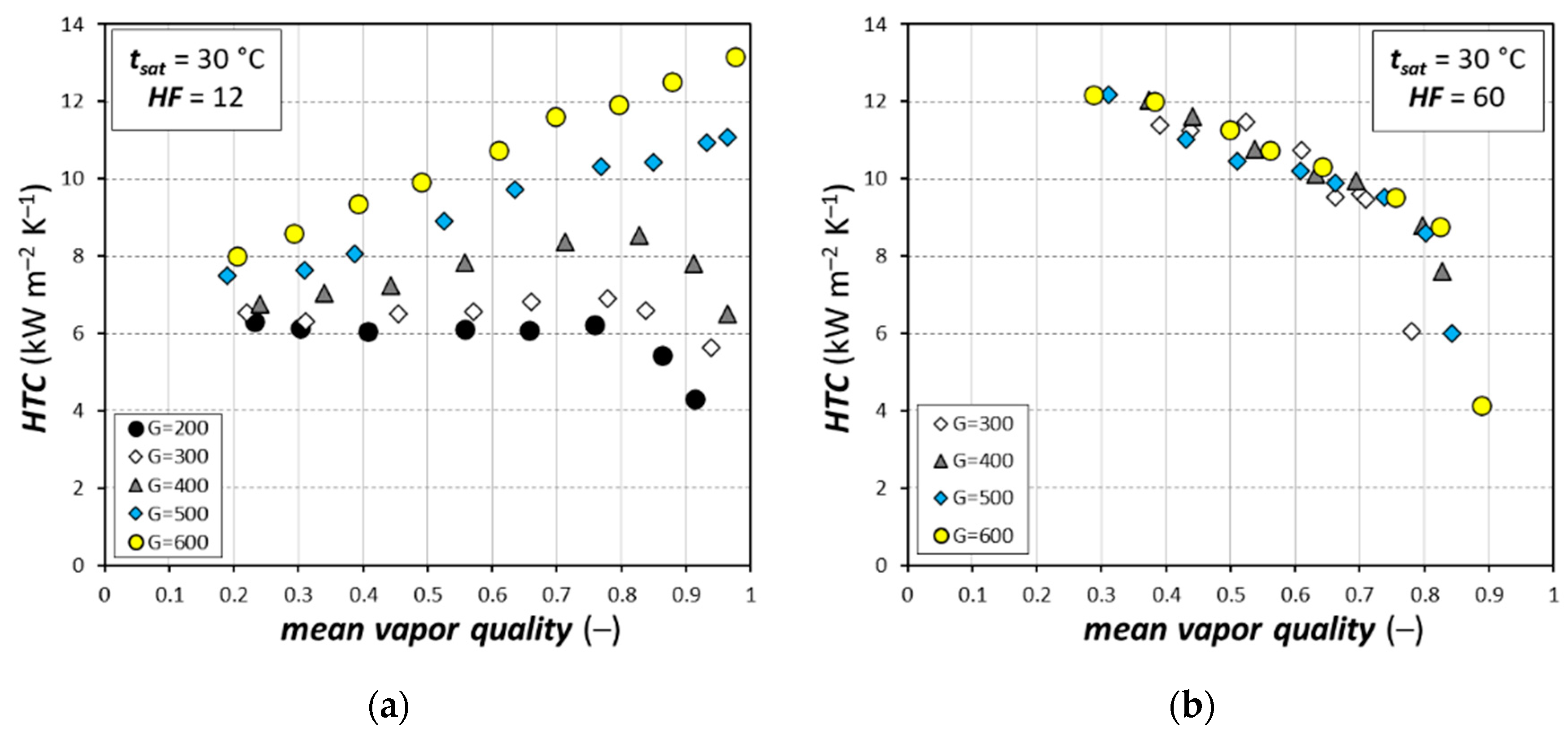
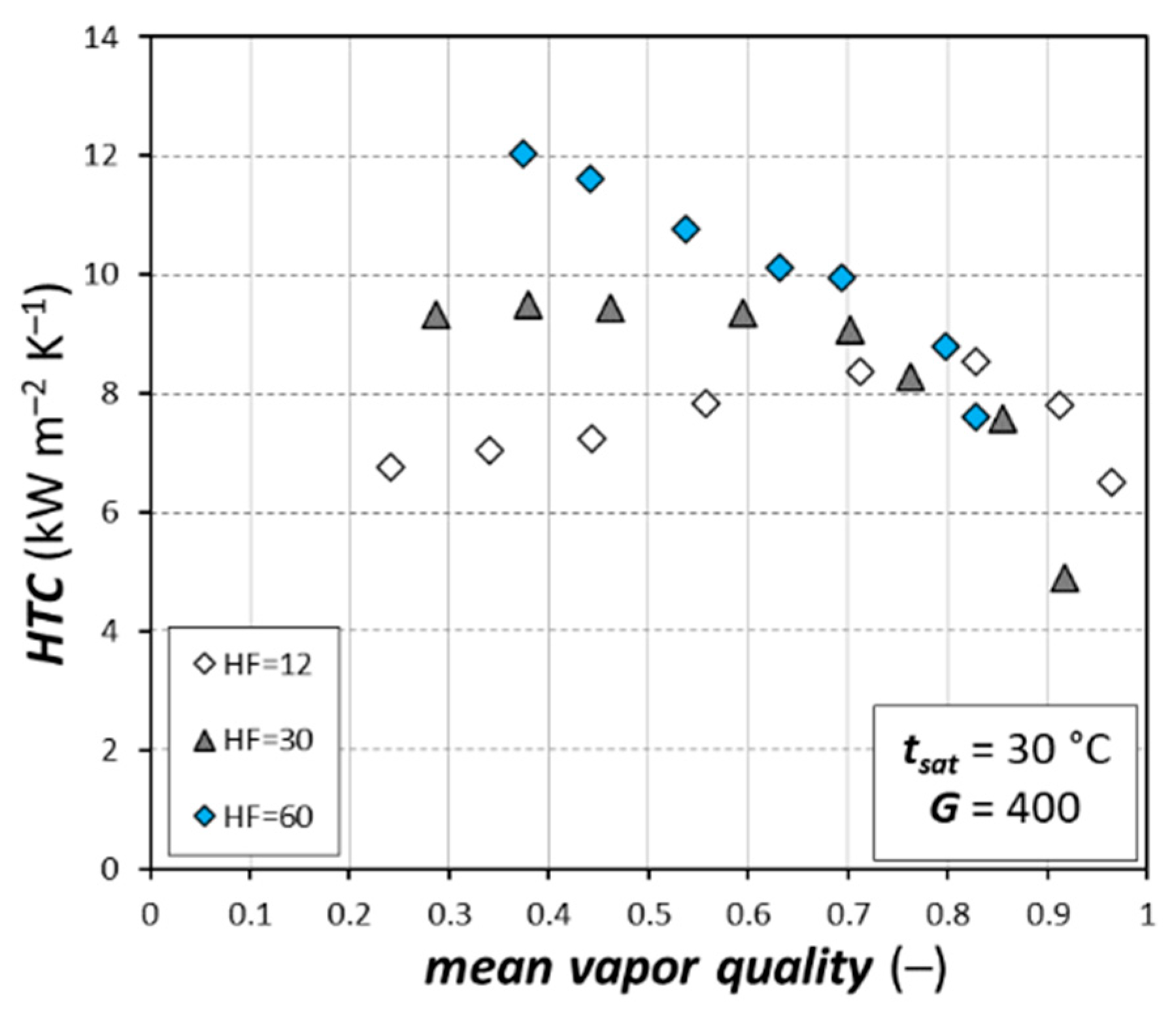
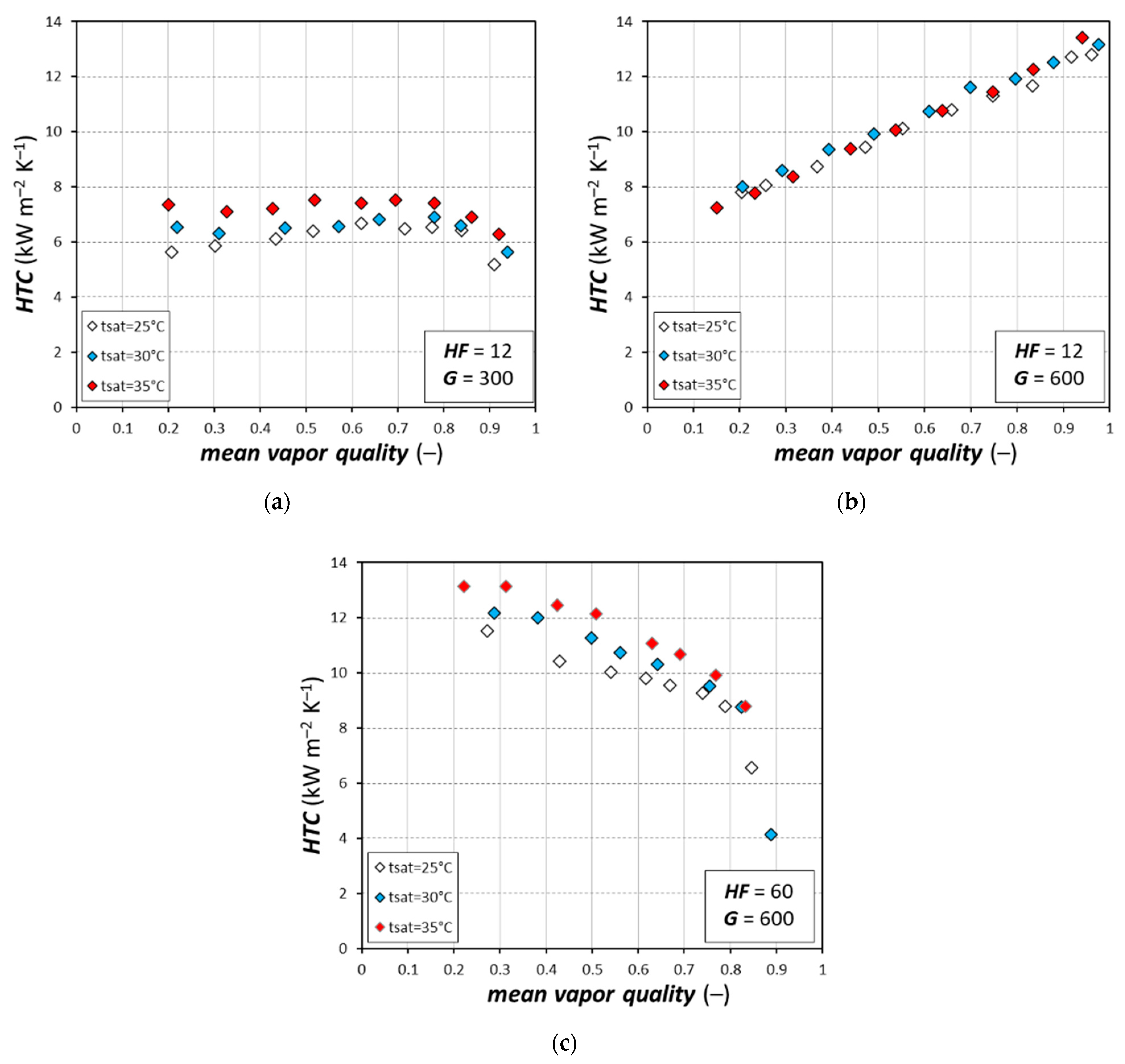
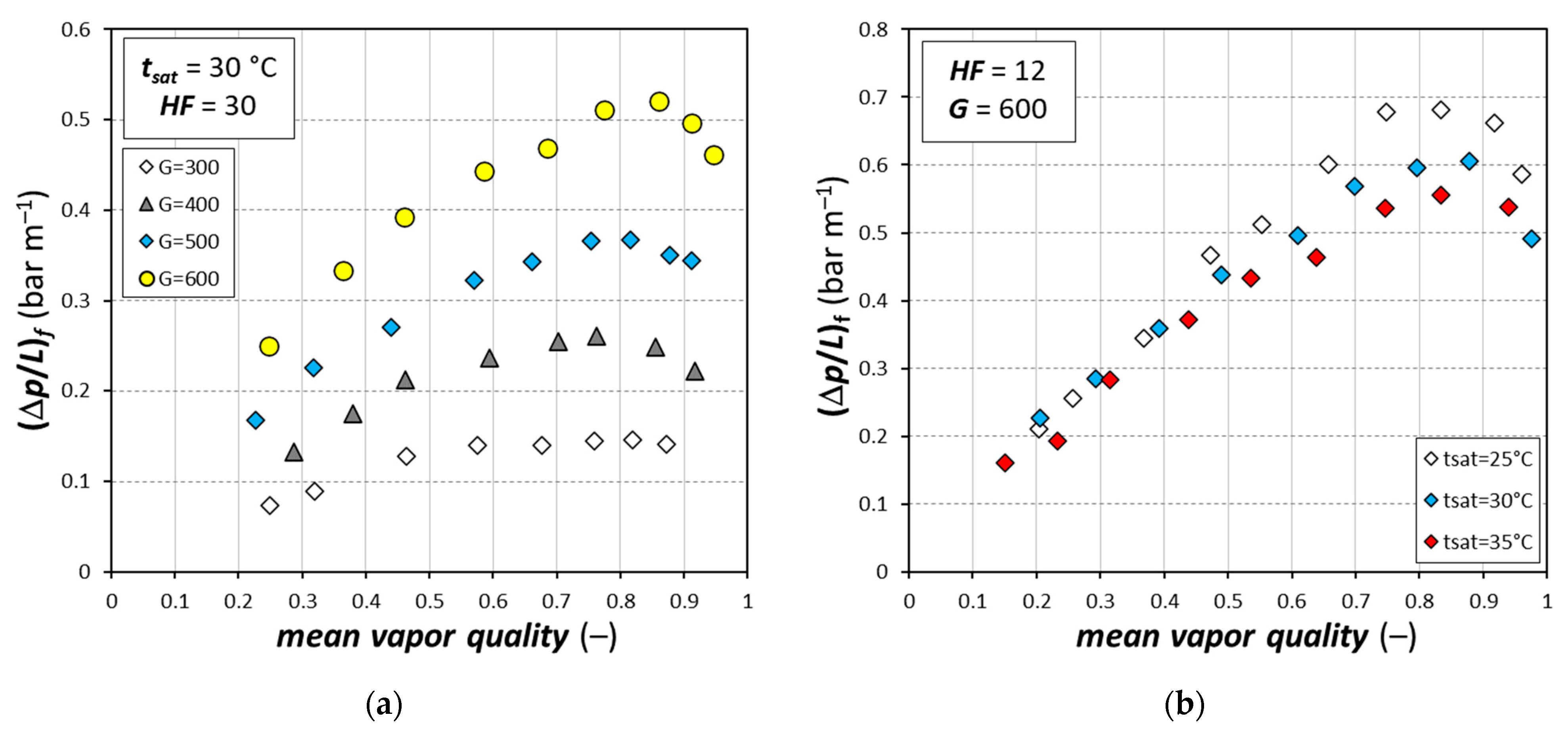

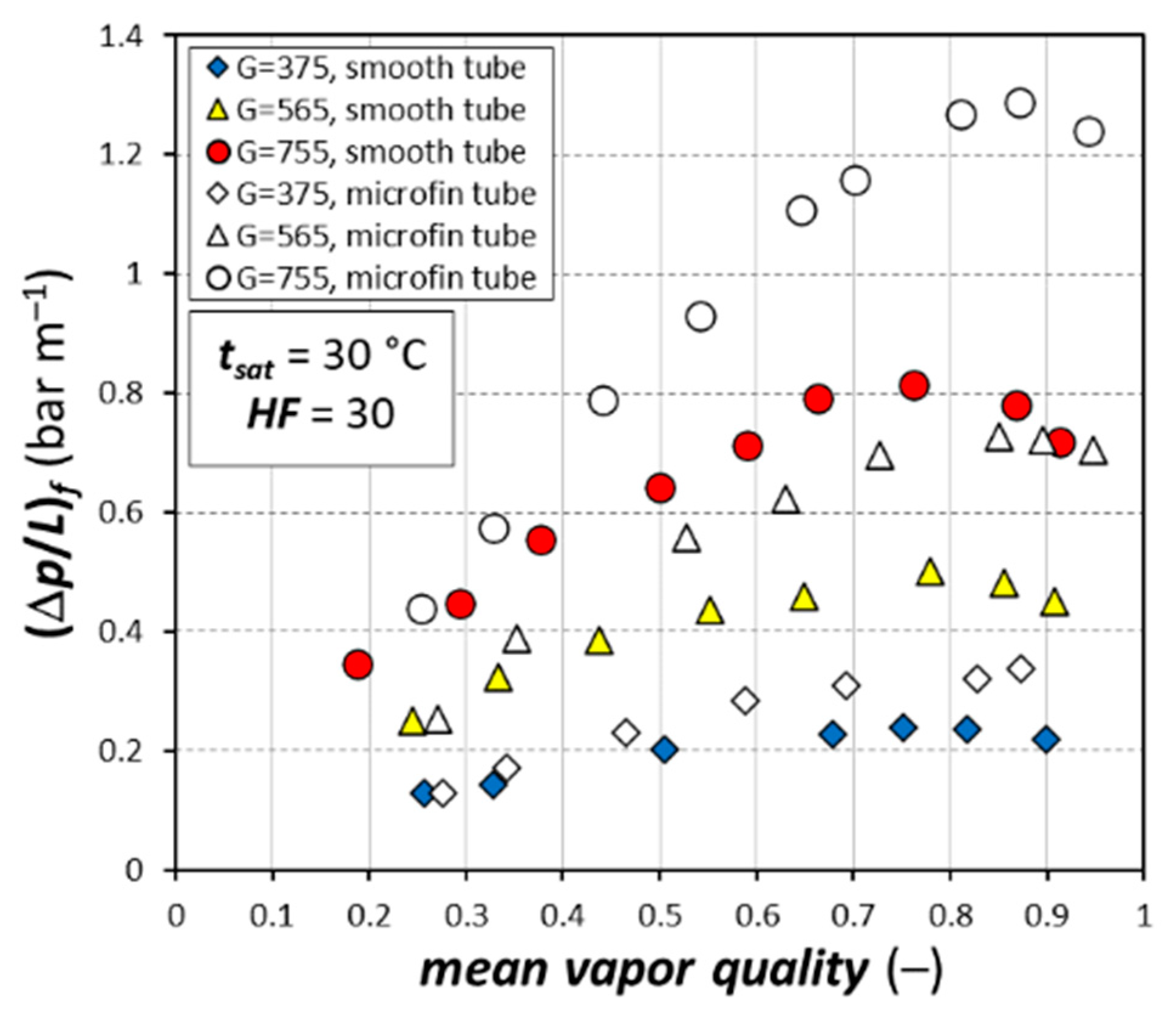

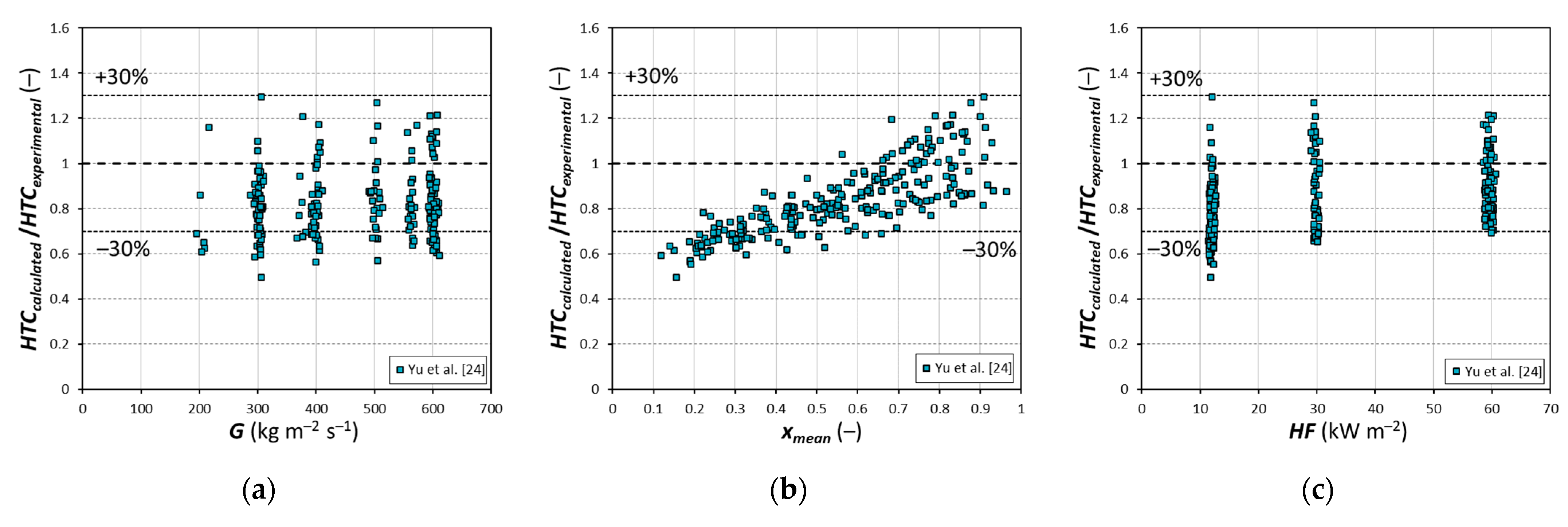

| Parameter | Type B Uncertainty |
|---|---|
| Refrigerant mass flow rate | ±0.1% of the reading |
| Water volumetric flow rate | ±0.25% of the reading |
| Temperature | ±0.05 K |
| Temperature difference | ±0.03 K |
| Electric power | ±0.13% of the reading |
| Absolute pressure | ±1950 Pa |
| Pressure drop | ±25 Pa |
Publisher’s Note: MDPI stays neutral with regard to jurisdictional claims in published maps and institutional affiliations. |
© 2021 by the authors. Licensee MDPI, Basel, Switzerland. This article is an open access article distributed under the terms and conditions of the Creative Commons Attribution (CC BY) license (http://creativecommons.org/licenses/by/4.0/).
Share and Cite
Diani, A.; Rossetto, L. R1234ze(E) Flow Boiling inside a 2.5 mm ID Smooth Tube and Comparison against an Equivalent Microfin Tube. Appl. Sci. 2021, 11, 2627. https://doi.org/10.3390/app11062627
Diani A, Rossetto L. R1234ze(E) Flow Boiling inside a 2.5 mm ID Smooth Tube and Comparison against an Equivalent Microfin Tube. Applied Sciences. 2021; 11(6):2627. https://doi.org/10.3390/app11062627
Chicago/Turabian StyleDiani, Andrea, and Luisa Rossetto. 2021. "R1234ze(E) Flow Boiling inside a 2.5 mm ID Smooth Tube and Comparison against an Equivalent Microfin Tube" Applied Sciences 11, no. 6: 2627. https://doi.org/10.3390/app11062627
APA StyleDiani, A., & Rossetto, L. (2021). R1234ze(E) Flow Boiling inside a 2.5 mm ID Smooth Tube and Comparison against an Equivalent Microfin Tube. Applied Sciences, 11(6), 2627. https://doi.org/10.3390/app11062627







